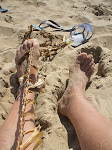"Urban Baskets" is arriving in Shetland soon - we hope. It closed in North Wales on Tuesday and now packed, and on the truck, we will be anxiously watching the weather forecasts, hoping the Aberdeen to Lerwick ferry won't be cancelled and that it will arrive in time for us to set it up at Bonhoga Gallery prior to the opening on the 25th. An interesting alternative might, however, be to let the public open the boxes and lay the show out on the opening night!
Shetland is on latitude 60, and it isn't until you travel the slow way that you really realise just how far north that is. Prior to each visit up here I spend hours on the internet trying to find the cheapest, most environmentally friendly and least physically exhausting way to do it. This time the result of this endeavour was a two day journey and 10 different means of transport. Car, train, taxi, plane,coach, bus,and then the Caledonian sleeper which rattled, clunked and swayed its way north overnight from Euston to Aberdeen. As it alternated between hurtling and crawling there was something strangely comforting about being tucked up in crisp white sheets whilst it did so.
The following day was spent wandering Aberdeen and at sunset, when the ferry slid out of the harbour on dark silky waters, it was hard to imagine being on a boat let alone on one of the roughest stretches of water around the British Isles. Fourteen hours later the 'Hjaltland' glided onto the berth in Lerwick, I haven't slept so soundly in ages. The weirdest effect of this languorous journey to the islands was that the subsequent 50 minute drive and ferry ride north to Mid Yell seemed to pass in the blink of an eye. Sometimes, after flying in to Shetland the same journey feels like an interminable trip to the very end of the earth. Which just goes to prove that time is flexible in between the rising and setting of the sun, it's only clocks that aren't.

Whilst in Aberdeen I visited the Maritime Museum. It is typical of many museums where the curators have tried to make the objects they treasure as entertaining as possible for everyone, regardless of whether or not these visitors have any interest in maritime history, or whatever else it is that the particular institution is hoarding. Consequently there is a stage set of a fisherman's cottage and a three storey model of an oil rig. The latter demonstrating very well that they are mechanical icebergs with the larger part under the surface. But, I find myself bored by the museum, there is nothing left for me to discover. It's all been picked over and cleaned and laid out by someone who is trying to determine exactly what I should understand, and experience, from each particular object. Of course, I am looking for baskets, but the curators obviously don't think baskets will draw the crowds.

Aberdeen has been an important port for fishing and the oil industry for a very long time and whilst there are few, if any, baskets used in the oil industry there used to be thousands used in fishing. There are a few crans and creels on display and some photos of them in use but no mention of where they were made or who made them. Were they men or women, this is seldom a foregone conclusion in basket making? Did they work in large workshops or was it done by 'out-workers' doing piece work in their own homes? Where did the materials came from? It is this last question that I am most curious about because many of the baskets made for the herring industry in the 19th Century employed whole rattan which came from South East Asia. It was used because it was incredibly strong and withstood the constant soaking with salt water but how did the basket makers in Britain at that time know this? And what triggered the importation of the rattan in the first place? In Shetland we have the tradition of the “willow kishie” which was actually made of rattan rather than willow, but, here there is a confusion of nomenclature that implies that the people using the rattan were not aware of what it was or where it came from and suggests that its use was circumstantial and pragmatic.

There was little I had not seen before among the fishing baskets in the museum but I was taken with this Northern Lighthouse Board transit basket (also made of rattan though described only as 'wicker' on the label) which was used to haul provisions up into lighthouses until very recently. The label also said these baskets were used because they were much lighter to haul up than the alternative wooden box. It might have been a way for the lighthouse keepers to avoid the stairs too, it was big and sturdy enough. Would I have preferred to be hauled up into a light house in the teeth of a gale in a basket or a wooden box ? I suppose it depends who made the basket and whether the box was made on a Friday afternoon or not! Personally I think either would be pretty scary.
The transit basket is no longer needed now as British light houses are all empty and automated, but it could have been a sustainable and cheap mode of transport - and definitely quite slow.









